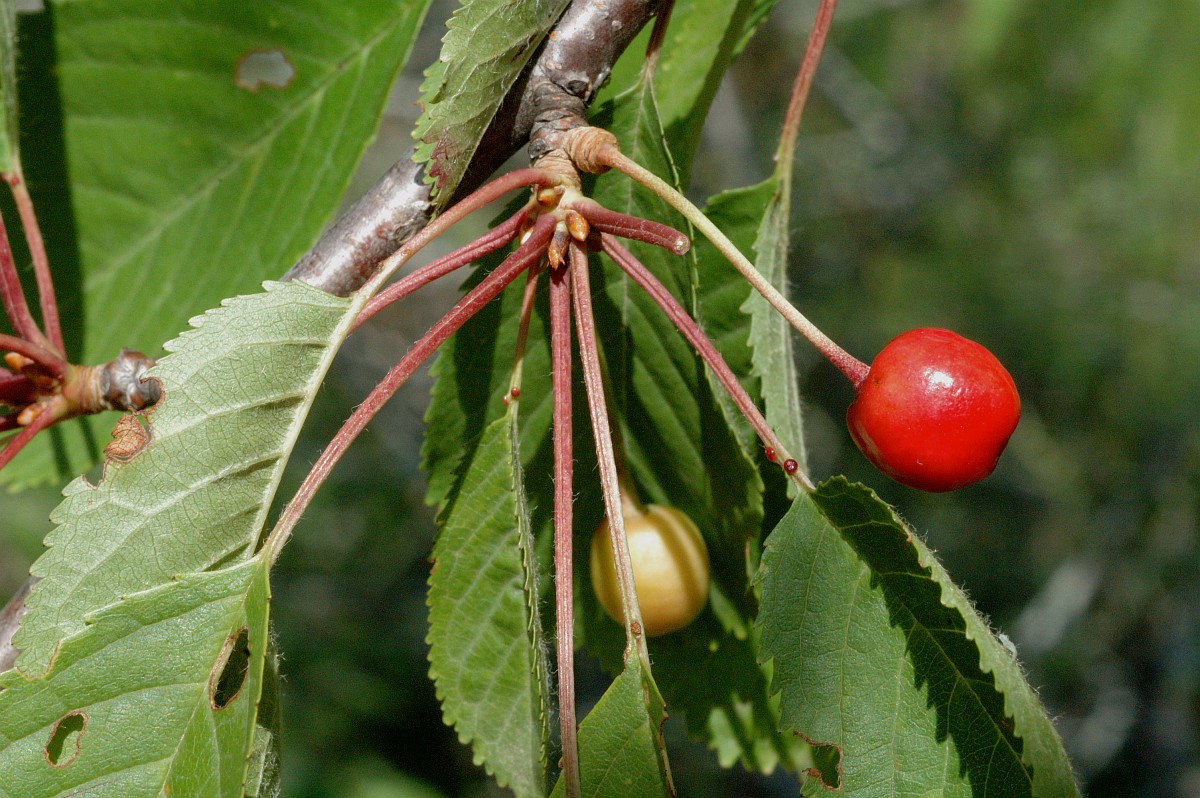Bird cherry identification and control
About this weed
Bird cherry is designated as a weed of concern in King County. This means control is not required, but is recommended, and new plantings are discouraged.
Bird cherry is known as Prunus avium, and it is in the rose family. It is also known as sweet cherry and mazzard cherry.

Why it’s a problem
Bird cherry was brought in as an ornamental tree and has spread widely throughout Washington state. It can crowd out native shrubs and small trees. Other than its fully ripened fruit, all parts of the plant are mildly toxic.
When it grows near a stand of the native cherry, bitter cherry, it will hybridize and produce sterile offspring. The hybrids will eventually replace the current trees and does not bear fruit. This removes a food source for birds and other native species.
Plant description
Bird cherry is originally from Europe. It was brought over as an ornamental tree. It has spread widely throughout Washington and much of North America.
Bird cherry is a deciduous (plant that loses its leaves annually) tree. Generally, it grows to about 50 feet tall with a broadly rounded crown. It is most often found in forest edges, urban woodlands, fields, and vacant lands.
It has smooth, peeling gray to brown or red to brown bark with prominent horizontal lenticels (stripes around the tree trunk).
The leaves are alternate, 2 to 5 inches long, oval with a pointed tip, and finely serrated (toothed on leaf edges). Leaves are dull green above and somewhat downy beneath, with 2 conspicuous red glands at the top of the petiole (leaf stalk).
Flowers are white, fragrant, and 1 inch across. They are in a loose cluster of 3 to 5 flowers, each with 5 petals, numerous stamens, and 1 pistil (like other wild cherry flowers). Flowers appear slightly before leaves emerge. Bloom time is April to May.
The fruit is a small, sweet cherry (one-half to 1 inch across), starting yellow then turning red to almost black when ripe in early summer. The fruit is eaten by birds and squirrels who have increased the spread of this tree.
Bird cherry spreads both through seed production and through sprouts from its root system.





Be aware of look-alike plants
When managing bird cherry make sure you're not removing bitter cherry, Prunus emarginata. Bitter cherry is the Pacific Northwest’s native cherry tree.
Bitter cherry is a shrub or small tree. In fact, everything about bitter cherry is smaller compared to bird cherry. The leaves are a quarter to a little over 3 inches long, thin, and egg shaped. The flowers are less than 1 inch long. The fruit is also smaller, less than half an inch in diameter. Bloom time is April to June.
Bitter cherry and bird cherry have also hybridized, creating Prunus x pugetensis also known as Puget Sound cherry. This plant has narrower leaves and smaller flowers than bird cherry and broader leaves and larger flowers than bitter cherry. The biggest difference is this tree is almost sterile and rarely bears any fruit.
When in doubt, take photos and report them on iNaturalist.
What to do if you find it
Because bird cherry is so widespread, property owners in King County are not required to control it. We are not generally tracking infestations.
The King County Noxious Weed Control Board encourages property owners to remove bird cherry where possible and to avoid introducing it to new landscapes. For more information or a site-specific recommendation in King County, contact our noxious weed program. For information in other locations, contact your local weed board.
Contact an arborist when removing a larger tree to ensure the safety of surrounding people and property.
Control methods
We recommend using a combination of methods to control weeds. In areas with few weeds, it is important to act quickly before they become harder to control. Make a long-term plan, as it often takes several years to get rid of most weeds. Start in the least infested areas first and then move into more heavily infested areas.
Manual control
Small and medium sized plants can be hand-pulled or dug out.
Try to remove all of the root system to avoid suckers sprouting from the disturbed root stock.
Chemical control
Stay safe when using herbicide:
- Always read the label before use.
- Wear a long-sleeved shirt, long pants, shoes, and eye protection.
- Follow state and local regulations.
Lancing and cut/treat methods have been effective in controlling bird cherry. Smaller plants and suckers can be treated with a foliar spray.
For more information or a site-specific recommendation in King County, contact the noxious weed program. For information in other locations, contact your local weed board or extension office.
Disposal instructions
Seeds should be bagged and disposed of separately. The remaining parts of the tree can be composted.
Noxious Weed Disposal - Washington State Noxious Weed Control Board

 Translate
Translate